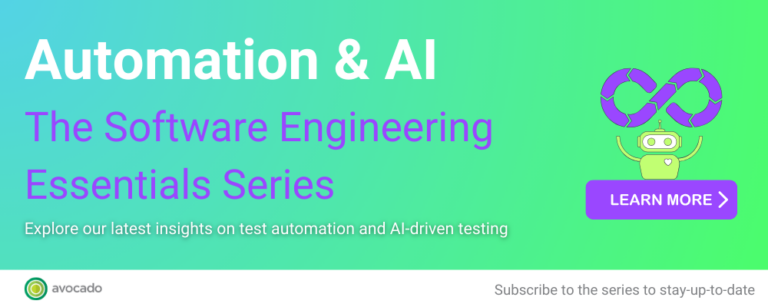Laying the Groundwork: Why Automation Is Essential Before AI in Testing
How Test Automation Sets the Stage for AI-Powered Quality Engineering
Artificial Intelligence (AI) is no longer a futuristic concept—it’s here, and it’s rapidly reshaping the world of software testing. From predictive analytics and autonomous script maintenance to smart test data generation, AI is enabling teams to test faster, smarter, and more efficiently.
But here’s the truth most teams overlook:
AI in testing is only as powerful as the automation framework beneath it.
Before you invest in AI-powered quality engineering, you must first establish a strong automation foundation. Why? Because test automation creates the stability, consistency, and data-rich environment that AI needs to thrive.
Without that, even the most advanced AI tools will struggle to add value—and may even introduce more complexity than clarity.
Why Automation Must Come First
- Automation Creates the Structure AI Needs
AI doesn’t function well in chaos. It depends on structured data, repeatable workflows, and measurable outputs—all of which come from test automation. When you automate core testing tasks like regression, smoke, and integration testing, you create a clean, reliable testbed for AI to work with.
A well-automated pipeline:
- Produces consistent pass/fail signals across builds
- Captures logs and metadata AI can use for learning
- Maintains stability for introducing dynamic, AI-driven test enhancements
Without automation, there’s no framework for AI to optimise.
- Automation Helps Identify Where AI Will Have Impact
Introducing AI into testing without automation is like buying a race car with no track.
Automation reveals:
- Where tests frequently fail or need rework
- Where maintenance overhead is high
- Which test gaps exist across environments or platforms
- Which tasks are truly repetitive and ripe for augmentation
With these insights, you can apply AI strategically—whether to prioritise test coverage, auto-generate missing tests, or predict risk areas.
- AI Scales Best in Automated Ecosystems
AI-driven testing tools—like those that self-heal selectors or suggest missing test cases—perform best when embedded into a stable delivery workflow.
That means:
- Your automation is integrated into CI/CD pipelines
- Test data is centralised and version-controlled
- Execution environments are reproducible and observable
When this maturity is missing, AI either fails to integrate—or becomes too unreliable to trust.
- Automation Simplifies AI Adoption
AI introduces change—new tools, new ways of working, and new types of output. Teams that are already comfortable with automation are far better prepared to handle that change.
Why? Because automation teaches teams to:
- Use toolchains effectively
- Work within structured pipelines
- Interpret data and logs systematically
- Collaborate across QA, Dev, and Ops
This familiarity makes it easier to adopt AI without overwhelming people or disrupting delivery.
- Automation Reduces Risk and Cost Before AI Enters the Picture
AI tools—especially enterprise-grade ones—can be expensive to implement and scale. Attempting to deploy them into a manual or ad hoc QA environment often leads to poor results, low adoption, and wasted investment.
Automation de-risks AI adoption by:
- Establishing baseline performance metrics
- Proving ROI at the test-case level
- Providing a clear integration point for intelligent add-ons
- Reducing noise that would otherwise mislead AI models
With automation in place, your team can focus on value-driving use cases rather than compensating for broken basics.
- Automation Prepares Teams to Work with AI
While AI may drive testing in the future, humans still need to understand, validate, and direct it.
Test automation builds the technical fluency your team will need to:
- Work with AI-generated test artifacts
- Troubleshoot AI-driven decisions
- Adapt automation strategies dynamically
- Understand ML-driven prioritisation or defect prediction
By mastering automation first, your team builds confidence and readiness for AI—making the shift a natural next step, not a disruptive leap.
AI and automation testing
From Automation to AI: A Natural Evolution
It’s tempting to treat AI as a shortcut to smarter testing – but without automation in place, it’s often a false start.
Test automation is more than a process accelerator – it’s the enabling layer that AI needs to succeed. It brings structure to your workflows, visibility to your pain points, and stability to your delivery pipelines. Once that foundation is set, AI can layer on intelligence, automation, and speed at scale.
At Avocado Consulting, we help clients build this foundation first – from CI-integrated automation frameworks to reusable test components and data-driven reporting. Once that’s in place, we work with clients to introduce AI incrementally and strategically, ensuring value at every step.
Take the First Step Toward Intelligent Testing
You don’t need to choose between automation and AI. You just need to start in the right order.
Begin by:
- Automating the basics
- Stabilising your test execution pipeline
- Capturing meaningful test data
- Building workflows your team can trust and scale
Once that’s done, AI becomes a multiplier—not a misstep.
Ready to make AI in testing a reality?
- Book a Test Automation Framework Review or Speak with an Avocado Expert via our enquiry page
- Stay updated by subscribing to this series via the pop-up on this page.
Read the first blog in this series, or discover more from this series – The Power of Test Automation in Software Testing?
It’s the first step in transforming your delivery pipeline—and your QA practice.











